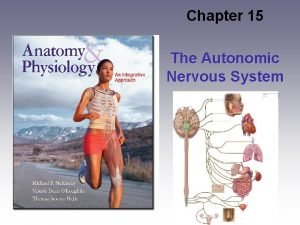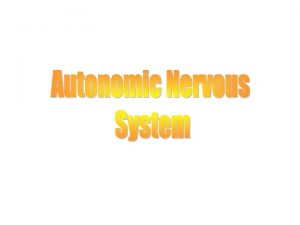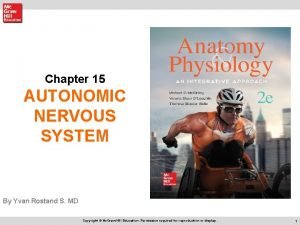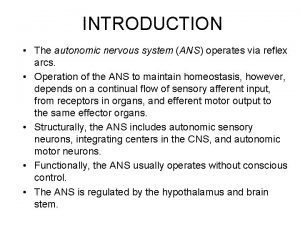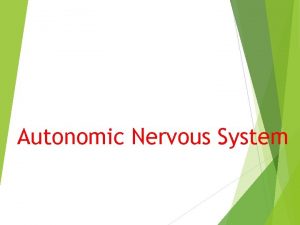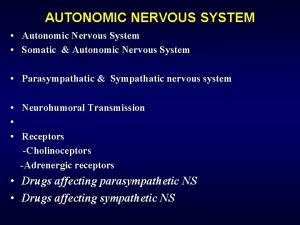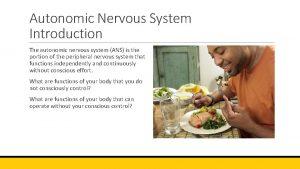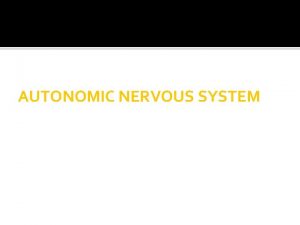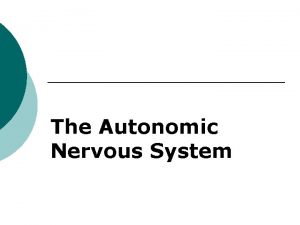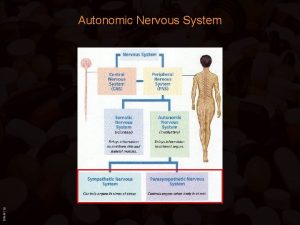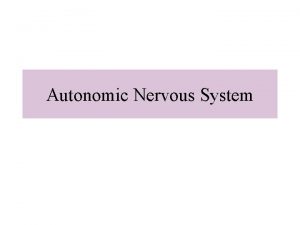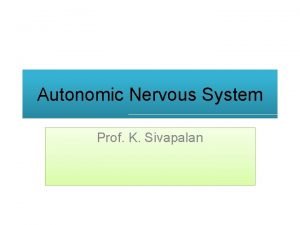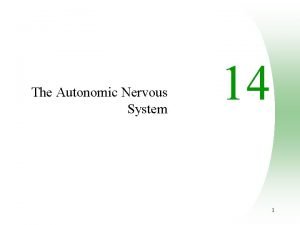Autonomic Nervous System Introduction Autonomic Nervous system consist















- Slides: 15

Autonomic Nervous System

Introduction Autonomic Nervous system consist of two main parts : 1 - sympathetic nervous system 2 - parasympathetic nervous system. Generally both sympathetic and parasympathetic innervate an organ. Some organs are supplied by only one system examples : Parasympathetic supplies : Ciliary muscles , glands of stomach and pancreas. Sympathies system supplies : Splenic , blood vessels , hair follicles and sweat glands.

Physiology of the parasympathetic system:

Physiology of the sympathetic system:

β Receptors:

Sympathomimetic drugs:

Sympathomimetic drugs: Similar effect to those produced by activity of the sympathetic nervous system: Epinephrine (adrenaline) act on α and β receptors Norepinephrine (noradrenaline) act on α receptors in all the body and β receptors in the heart

Clinical situations where sympathetic drugs used for : Cardiac stimulants : : noradrenaline , adrenalin Nasal decongestants : Ephedrine Bronchodilators : Salbutamol and salmeterol Anorectics( person suffering from anorexia ) : mazindol CNS stimulants : Ephedrine and amphetamine Uterine relaxants and vasodilators : Isoxsuprine

Epinephrine (adrenaline) action: Adrenaline drugs : 1 - Increase palpitation 2 - Rise in systolic blood pressure , increase the output of blood by heart 3 - Relaxes smooth muscles including bronchial tree 4 - Rises blood sugar by mobilizing glucose from tissues Uses: asthma , Treatment of allergy reactions and cardiac resuscitation adverse reaction Pulmonary edema, subarachnoid hemorrhage , blood sugar increase

Norepinephrine (noradrenaline) action:

Selective β 2 agonists: Effective bronchodilators Minimum effect on the heart Examples: Salbutamol( Ventolin ) Powerful bronchodilator Rapid & short acting (4 hr ) Use: Treatment of bronchospasm due to asthma or bronchitis Can be taken : Prophylaxis( help in preventing asthma to happen ) To relive an attack or on a regular basis

Salbutamol Can be given: Orally, Inhalation, Slow IV Side effects on large doses: Tremor(shaking) Tachycardia(increase in palpitation ) Salmeterol: Longer acting than salbutamol Lasts about 12 hr Shouldn’t be used for rapid effect in treat an acute attack Twice daily dose Can be combined with inhaled steroids

Selective α Agonistic Drugs Clonidine : It’s a dug which used to: 1 - treat moderate hypertension 2 - treat the moderate withdrawal symptoms of alcohol and barbiturates. Side effects : 1 - depression 2 - dry mouthed 3 - headache

Other sympathomimetic drugs: Amphetamine & dexamphetamine: Amphetamine drugs : Central nervous system effects Add to barbiturates because it case sleep and fatigue Treat hyperkinetic syndrome in children This drug should not be used as better drugs are available

To be continued
 Parasympathetic
Parasympathetic Somatic motor neuron
Somatic motor neuron Autonomic nervous system consists of
Autonomic nervous system consists of Somatic and autonomic nervous system
Somatic and autonomic nervous system Ganglion on spine
Ganglion on spine Autonomic nervous system
Autonomic nervous system The autonomic nervous system controls
The autonomic nervous system controls Parasympathetic and sympathetic
Parasympathetic and sympathetic Autonomic nervous system
Autonomic nervous system Major divisions
Major divisions Fundamentals of the nervous system and nervous tissue
Fundamentals of the nervous system and nervous tissue Fundamentals of the nervous system and nervous tissue
Fundamentals of the nervous system and nervous tissue Processes of neuron
Processes of neuron What does an ict system consist of
What does an ict system consist of Autonomic nerveous system
Autonomic nerveous system Oculomotor nerve
Oculomotor nerve





